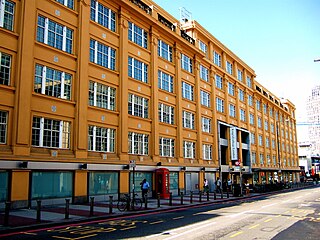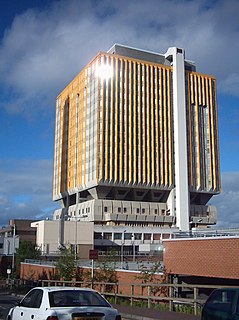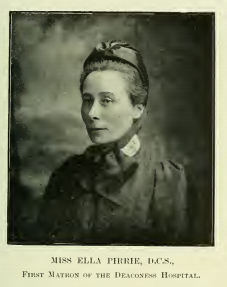
Florence Nightingale was an English social reformer, statistician and the founder of modern nursing. Nightingale came to prominence while serving as a manager and trainer of nurses during the Crimean War, in which she organised care for wounded soldiers at Constantinople. She significantly reduced death rates by improving hygiene and living standards. Nightingale gave nursing a favourable reputation and became an icon of Victorian culture, especially in the persona of "The Lady with the Lamp" making rounds of wounded soldiers at night.

In Britain, a workhouse was an institution where those unable to support themselves financially were offered accommodation and employment. The earliest known use of the term workhouse is from 1631, in an account by the mayor of Abingdon reporting that "we have erected wthn [sic] our borough a workhouse to set poorer people to work".

The Liverpool Royal Infirmary was a hospital in Pembroke Place in Liverpool, England. The building is now used by the University of Liverpool.

The Florence Nightingale Faculty of Nursing, Midwifery & Palliative Care is an academic faculty within King's College London. The faculty is the world's first nursing school to be continuously connected to a fully serving hospital and medical school. Established on 9 July 1860 by Florence Nightingale, the founder of modern nursing, it was a model for many similar training schools through the UK, Commonwealth and other countries for the latter half of the 19th century. It is primarily concerned with the education of people to become nurses and midwives. It also carries out nursing research, continuing professional development and postgraduate programmes. The Faculty forms part of the Waterloo campus on the South Bank of the River Thames and is now one of the largest faculties in the university.

William Rathbone VI was an English merchant and businessman noted for his philanthropic and public work. He was an English Liberal politician who sat in the House of Commons variously between 1868 and 1895.

The Belfast City Hospital in Belfast, Northern Ireland, is a 900-bed modern university teaching hospital providing local acute services and key regional specialities. Its distinctive orange tower block dominates the Belfast skyline being the third tallest storeyed building in Ireland. It has a focus on the development of regional cancer and renal services. It is managed by Belfast Health and Social Care Trust and is the largest general hospital in the United Kingdom. In April 2020, due to the global coronavirus pandemic, the tower block was designated one of the UK's Nightingale Hospitals.
Lucy Osburn was an English nurse trained at the School of Nursing founded by Florence Nightingale. She is regarded as the founder of modern nursing in Australia.

Agnes Elizabeth Jones of Fahan, County Donegal, Ireland became the first trained Nursing Superintendent of Liverpool Workhouse Infirmary. She gave all her time and energy to her patients and died at the age of 35 from typhus fever. Florence Nightingale said of Agnes Elizabeth Jones, ‘She overworked as others underwork. I looked upon hers as one of the most valuable lives in England.’

Eva Charlotte Ellis Luckes was Matron of The London Hospital from 1880 to 1919.

Dame Mary Rosalind Paget, DBE, ARRC, was a noted British nurse, midwife and reformer. She was the first superintendent, later inspector general, of the Queen's Jubilee Institute for District Nursing, which was renamed as the Queen's Institute of District Nursing in 1928 and as the Queen's Nursing Institute in 1973.
Florence Sarah Lees was one of the English pioneers of district nursing.
In 2002, nursing homes in the United Kingdom were officially designated as care homes with nursing, and residential homes became known as care homes.
The history of nursing in the United Kingdom relates to the development of the profession since the 1850s. The history of nursing itself dates back to ancient history, when the sick were cared for in temples and places of worship. In the early Christian era, nursing in the United Kingdom was undertaken by certain women in the Christian Church, their services being extended to patients in their homes. These women had no real training by today's standards, but experience taught them valuable skills, especially in the use of herbs and folk drugs, and some gained fame as the physicians of their era. Remnants of the religious nature of nurses remains in Britain today, especially with the retention of the job title "Sister" for a senior female nurse.
The Bedwellty Union Workhouse was situated in Georgetown, Tredegar. It is 2.9 miles (4.7 km) from the Nanybwtch Junction A465. The building was in existence for approximately 127 years. The workhouse building was also used as a hospital. Today, the site where the building once stood, there is a housing estate known as St James Park.
Rebecca Strong was an English nurse who pioneered preliminary training for nurses.
The Workhouse Infirmary Nursing Association was created in 1879 to organise training and act as an employment agency for nurses in Poor law infirmaries and workhouses.
Workhouse infirmaries were established in the nineteenth century in England. They developed from the Workhouse and were run under the Poor law regime.

Miss Isabella "Ella" Barbour Pirrie, DCS (1857–1929), was the first nurse in the Belfast Union Workhouse Infirmary, establishing a nursing school there. She went on to become the first matron at the Deaconess Hospital, Edinburgh, established by Archibald Charteris as a training school for nurses.
Fulham Hospital was an English hospital in the west London district of Fulham from 1884 to 1973. From 1957 onwards it was merged with the Charing Cross Hospital and gradually demolished. Charing Cross Hospital relocated from central London and now occupies the former Fulham Hospital site, south of St Dunstan's Road.

Dulwich Community Hospital was a hospital located in Dulwich, London. It was replaced by a modern health centre on the same site in April 2020.












